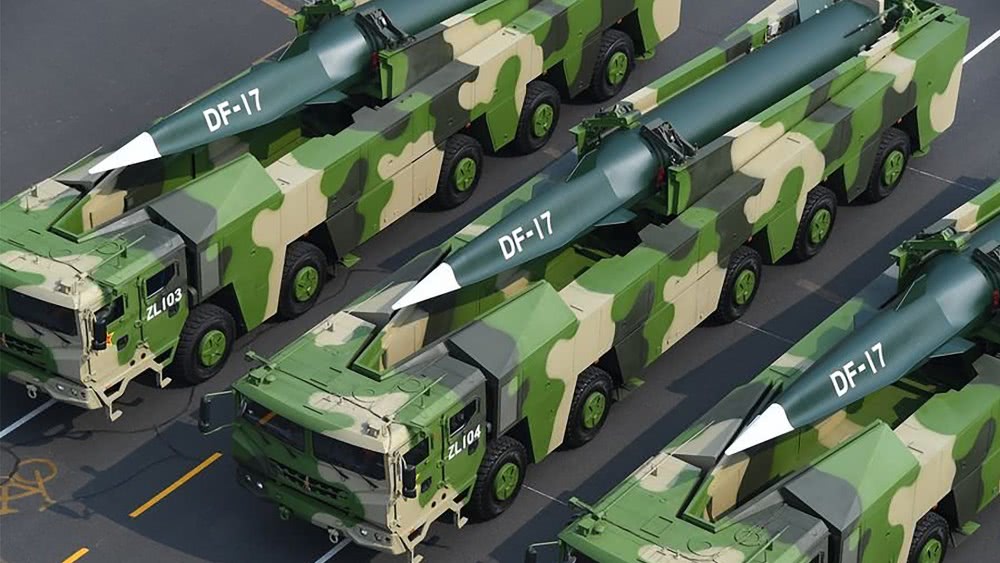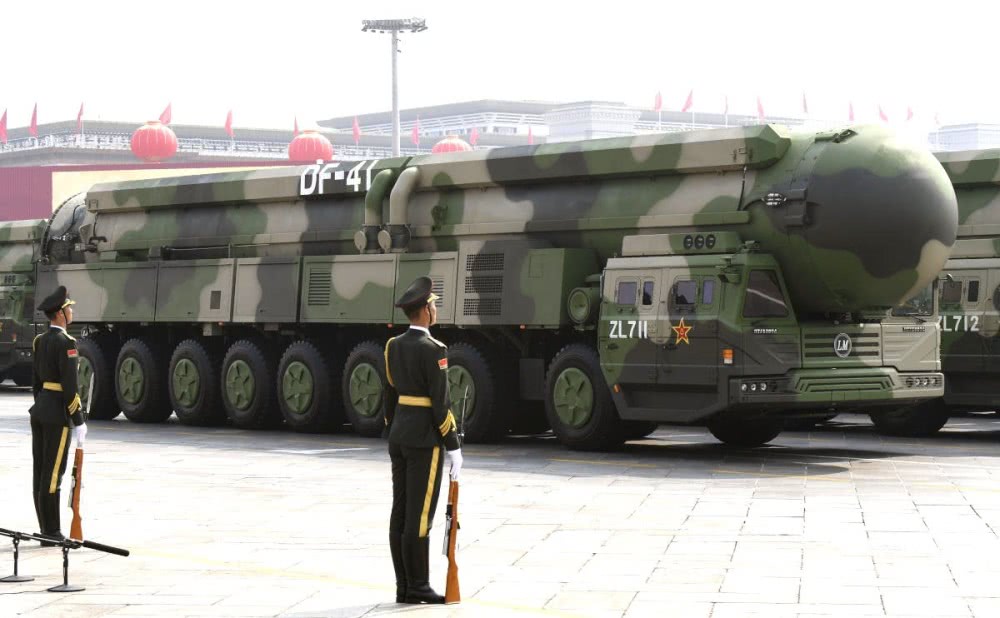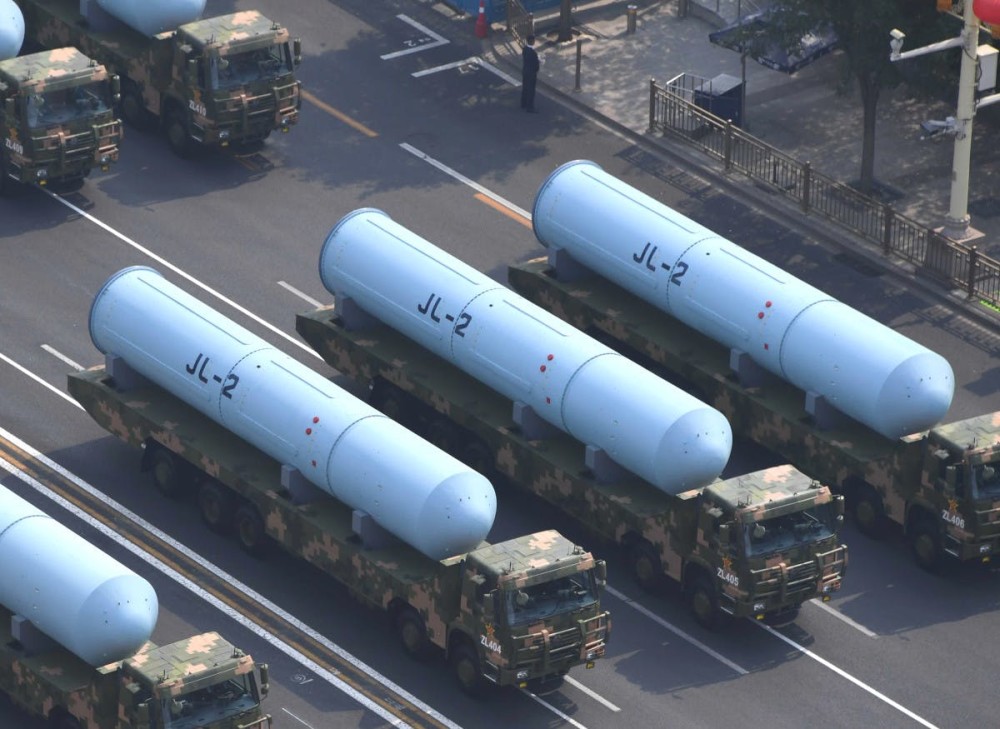| Strategic Weapons: Chinese Mystery Nukes
战略武器:中国神秘核打击力量 Date:2020-04-20 Source:strategypage By:Globalmil Viewed: |
2020年4月19日:去年,中国用于测试和发展导弹的发射次数超过世界其他地区的总和。中国是一个核大国,并不特别在乎拥有多少核和运载系统。中国也更有能力对大多数导弹测试保密。中国并没有向海上发射导弹,在那里他们必须向船只发出警告,以避开弹头将要降落的区域。而是在戈壁沙漠附近的内陆试验场进行了大部分导弹试验。宽敞的空间,不会被窥视。唯一知道中国每年进行多少次导弹试验的国家是美国,美国拥有一个遍布全球的预警卫星网络,该网络可以发现地球上任何地方发射的弹道导弹所产生的热量。美国不会透露他们每年发现多少枚中国导弹,但在2018年的讲话中,一位美国官员评论说中国每年发射的导弹数量超过世界其他地区的总和。此后类似的评论表明,中国目前每年要发射一百多枚导弹,其中大多数是在西北偏远的内陆试验场发射的。美国还拥有可以收集遥测数据的电子监视卫星网络。这就是探测弹头发射重回地面的有关导弹性能的信息。此数据已加密,美国对捕获和解密了多少这些信号说得很少。
The U.S. is very interested in finding out details of new Chinese missiles because some will gave capabilities and the U.S. and Russia gave up for several decades because of the INF (Intermediate-Range Nuclear Forces) disarmament treaty signed near the end of the Cold War. The U.S. did admit that the main reason for not renewing the UNF Treaty with Russia in 2019 was not just Russian cheating but also because China never signed the INF treaty and is free to develop the ballistic and cruise missiles with ranges of 500 to 5,500 kilometers the INF forbids.
美国对了解新型中国导弹的细节非常感兴趣,因为某些导弹将提供能力,因而美国准备放弃冷战临近结束时签署的裁军《中程核力量条约》(INF),在美国和俄罗斯之间存续数十年。美国确实承认,2019年不与俄罗斯续签《中程核力量条约》的主要原因不仅仅是俄罗斯作弊,还因为中国从未签署过《中程核力量条约》,因而可以自由开发射程为500至5500公里的弹道导弹和巡航导弹,《中程核力量条约》是禁止的。
China also pretends it is unconcerned about who the target is. In 2009, China announced that its nuclear armed ballistic missiles were not aimed at anyone. Like most countries, China has long refused to say who its nuclear armed missiles are aimed at. Most of those missiles only have enough range to hit Russia, or India, or other nearby nations. For a long time, most were very definitely aimed at Russia, which had rocky relations with China from the 1960s to the 1990s. But after the Soviet Union dissolved in 1991, the new, much smaller, Russia became much friendlier with the wealthier (more capitalist, but still run by communists) China. Relations between China and India also warmed up then went into a deep freeze.
中国还假装对目标是谁并不关心。2009年,中国宣布其核武装弹道导弹没有针对任何人。像大多数国家一样,中国长期以来一直拒绝透露其核武导弹的目标。这些导弹中的大多数只具有足以击中俄罗斯,印度或其他附近国家的射程。长期以来,大多数武器无疑都瞄准了前苏联,从1960年到1990年与中国关系不佳。但是在1991年前苏联解体后,新的,规模更小的俄罗斯与富裕的中国(更加资本主义,但仍由共产党主政)变得更加友好。中国和印度之间的关系也开始升温,随后陷入了僵局。
China is believed to have 300-400 nuclear warheads, most of them installed on ballistic missiles. Fewer than a hundred of these missiles can reach the United States. These include the older (and about to be retired) DF-5, plus the newer DF-31A and DF-41.
据信中国拥有300-400枚核弹头,其中大多数安装在弹道导弹上。这些导弹中只有不到一百枚可以到达美国。其中包括较旧(即将退役)的DF-5型,以及较新的DF-31A型和DF-41型。
Few Chinese ballistic missiles are armed with nuclear warheads as the Chinese strategy is to use lots of ballistic missiles armed with high-explosive warheads. In the early stages of a war over a thousand of these shorter range missiles can overwhelm air and ballistic missile defense systems to damage or destroy airbases, warships headquarters and other key targets. For over a decade China has had over a thousand of these missiles based within range of Taiwan. Many of these missiles are mobile and a large number could be moved to threaten Japan or South Korea.
很少有中国弹道导弹装备核弹头,因为中国战略是使用大量配备常规高爆弹头的弹道导弹。在战争初期,一千多种这类短程导弹会淹没空中和弹道导弹防御系统,以破坏或摧毁空军基地,军舰总部和其他关键目标。十多年来,中国在台湾地区范围内拥有上千枚此类导弹。这些导弹中有许多是可机动的,并且可能会大量机动以威胁日本或韩国。
China is believed to have about 2,000 ballistic missiles, most of them short (under a thousand kilometers) range plus over 300 cruise missiles. China is developing more cruise missiles concentrating, as is the United States, on stealth and additional capabilities. Chins is also developing and deploying many new missiles. In fact China has more types of ballistic missiles, at least 40, than any other nation. China also invests heavily in its new missile technologies, like its hypersonic glide missile, the DF-ZF.
据信,中国拥有大约2,000枚弹道导弹,其中大多数是短程(不到一千公里),外加300多枚巡航导弹。与美国一样,中国正在开发更多的巡航导弹,其重点是隐身性和附加能力。中国也正在开发和部署许多新型导弹。实际上,中国拥有的弹道导弹种类最多,至少有40种。中国还大力投资其新型导弹技术,例如高超音速滑翔导弹DF-ZF。
China is known to have a large number of ICBM and shorter range IRBM missiles. These include about twenty DF-41 (range of 14,000 kilometers), about eighty DF-31 - 50 (8,000 kilometers), thirty DF-5 - ( 14,000 kilometers), thirty DF-4 (5,500 kilometers), eighty DF-26 (4,000 kilometers), fifty DF-21D Anti-Ship Ballistic Missile – fifty (1,500 kilometers), 300 DF-21 (1,700 kilometers), fifty DF-16 (800 kilometers), 300 DF-15B (800 kilometers), 500 DF-15A (900 kilometers), 1,200 DF-11A (700 kilometers). The only cruise missile is the CJ-10A (1,500 kilometers). There are several hundred other short range ballistic missiles as well, some of them still in development.
众所周知,中国拥有大量的洲际弹道导弹( ICBM)和短程、中程弹道导弹(IRBM)导弹。 其中包括约20枚DF-41(航程14,000公里),约80枚DF-31(8,000公里),三十枚DF-5(14,000公里),三十枚DF-4(5,500公里)和80枚DF-26( 4,000公里),五十枚DF-21D反舰弹道导弹(1,500公里),300枚DF-21(1,700公里),五十枚DF-16(800公里),300枚DF-15B(800公里),500枚DF- 15A(900公里),1,200枚DF-11A(700公里)。唯一的巡航导弹是CJ-10A(1,500公里)。另外还有数百种短程弹道导弹,其中一些仍在研发中。
Since the 1990s China has always had a few active DF-5 ICBMs. For a long time these were their only missiles that could reach the United States. But the U.S. has since installed 18 ICBM interceptor missile systems in Alaska. There are to deal with North Korean missiles, but could also destroy most Chinese missiles headed for the western United States. Thus it makes sense for China to simply say that it is not aiming any of its missiles at anyone. Modern guidance systems can be quickly (in less than an hour) programmed for a new target, so it doesn't really matter that, normally, the missiles have no target information in them. The DF-5s, moreover, are liquid fueled, and the considerable activity required to ready them for launch can be detected by spy satellites.
自1990年以来,中国一直有一些现役的DF-5洲际弹道导弹。很长一段时间以来,这是他们唯一可以到达美国的导弹。但是美国此后在阿拉斯加安装了18套洲际弹道导弹拦截系统。朝鲜的导弹是要应对的,但也有可能摧毁大多数射往美国西部的中国导弹。因此,中国可以简单地说,它没有将任何导弹对准任何人。现代制导系统可以快速(不到一小时)为一个新目标编程,因此,通常情况下,导弹中没有目标信息并不重要。而且,DF-5是液体燃料,间谍卫星可以探测到准备发射所需的大量活动。
The DF-5s have been largely replaced by solid fuel DF-41s. These missiles can be moved, erected and launched from a special truck. With a 15,000 kilometer range, they can reach all of the United States. The third stage contains up to twelve warheads, each with an explosive yield of about 100 KT.
DF-5已被固体燃料DF-41取代。这些导弹可以通过专用卡车进行机动,竖起和发射。它们的射程为15,000公里,可以到达全美国。第三级包含多达十二个分导弹头,每个弹头的爆炸当量约为100 KT。
India is of growing concern to China, but there are shorter range ballistic missiles, like the DF-21, to deal with that threat. The Chinese introduced the DF-21 in 1999 and now has over a hundred in service. Many have non-nuclear warheads. This missile has a range of over 1,800 kilometers and can haul a 300 kiloton nuclear warhead. It's a two stage, 15 ton, solid fuel rocket. Launched from Tibet, the DF-21 can reach most major targets in India.
印度日益受到中国的关注,但中国有较短射程的弹道导弹(例如DF-21)来应对这种威胁。中国于1999年生产DF-21,目前已有100多枚服役。大多数配备无核弹头。该导弹的射程超过1800公里,可携带300吨级核弹头。这是两级15吨重固体燃料火箭。DF-21从西藏发射升空,可以到达印度的大多数主要目标。
Back in 2006China put the larger DF-31 into service. Sort of. This was China's first solid fuel ICBM (with a range of over 8,000 kilometers) and roughly equivalent to the U.S. Minuteman I of the 1960s. The DF-31 weighs about 46 tons and is 20 meters (62 feet) long and 2.25 meters (7 feet) in diameter. It was designed for use on submarines, land silos and mobile launchers (which would halt at those "parking lots in the middle of nowhere" visible in satellite pictures of Qinghai province). The DF-31 has been shown stored in a TEL (transporter, erector, launcher) vehicle. Driving these vehicles along special highways in remote areas provides more protection from counterattacks, than using a reinforced silo. Later, the improved DF-13A appeared, with multiple warheads and more range (up to 12,000 kilometers, which could cover all the United States.)
早在2006年,中国就将更大的DF-31投入使用。这是中国第一种固体燃料洲际弹道导弹(航程超过8,000公里),大致相当于1960年的美国民兵- I 型。DF-31重约46吨,长20米(62英尺),直径2.25米(7英尺)。它被设计用于潜艇,陆上发射井和机动发射装置(它们会停在青海卫星图片中可见的“遥远偏僻处的停车场”)。DF-31已显示存储在TEL(运输,竖起,发射)车辆中。与使用加固的发射井相比,在偏远地区的特殊高速公路上驾驶这些车辆提供了更多的反击保护。后来出现了改进的DF-13A,它具有多个弹头和更大的射程(可达12,000公里,可以覆盖整个美国)。
The DF-31 was in development for over twenty years, and only had its first successful launch in 1999. It's now believed to have a reliable and accurate guidance system, as well as a third stage that carries three 50 kiloton warheads. DF-31s are in service, along with DF-31As and most of these appear to be aimed at European Russia.
DF-31的研发已经进行了20多年,直到1999年才首次成功发射。现在,它被认为具有可靠且准确的制导系统,以及第三级可携带三个50吨弹头。DF-31和DF-31A一起服役,其中大多数似乎针对欧洲俄罗斯。
Then there is a submarine launched missile the JL (Julang) 2 SLBM (Sea Launched Ballistic Missile). This missile has had a lot of problems as have the SSBNs (ballistic missile carrying nuclear subs) that carry them. The 42 ton JL-2 has a range of 8,000 kilometers, and would enable China to aim missiles at any target in the United States from a 094 class SSBN cruising off Hawaii or Alaska. Each 094 boat can carry twelve of these missiles, which are naval versions of the existing land based 42 ton DF-31 ICBM. The JL-2 was supposed to have entered service 2015, but kept failing test launches. China decided that JL-2 was reliable enough and ordered it installed in four SLBMs. No Chinese SSBN has ever gone on a combat cruise, because these boats, as well as the SLBMs, have been very unreliable.
然后是一种潜射导弹JL(巨浪,Julang)2型潜射弹道导弹(SLBM)。这种导弹和携带的弹道导弹核潜艇(SSBN)都存在很多问题。这种42吨重的JL-2射程为8000公里,将使中国能够从夏威夷或阿拉斯加航行的094型弹道导弹核潜艇向美国的任何目标发射导弹。每艘094型潜艇可携带12枚此类导弹,这是现有陆基42吨DF-31型洲际弹道导弹的海军版本。JL-2原定于2015年服役,但一直未能通过测试。中国认为JL-2足够可靠,并下令将其安装在四艘弹道导弹核潜艇(SSBN)中。中国的弹道导弹核潜艇从未进行过战斗巡航,因为这些潜艇以及潜射弹道导弹都很不可靠。
About two thirds of Chinese nuclear warheads are believed to be in missile warheads, most of them DF-21s. Normally, these warheads are stored separately and mated to the missiles only for actual use, or the occasional training exercise.
据信,中国约三分之二的核弹头是导弹弹头,其中大多数是DF-21。通常,这些弹头与配合使用的导弹单独存放,仅用于实际使用或偶尔进行训练。
上一篇:US Deploys New Low-Yield Nuclear Submarine Warhead 下一篇:Naval Air: China Takes An Intimidation Hit
| The Booker dilemma: inside US Army transformation
“布克”困境:美国陆军转型内幕 |
| The decision to cancel the M10 Booker light tank is at the core of a reordering of US Army planning.... [2025-07-16] |
| Focus: A fragile balance in Asia, China has become leading military power in the
焦点:亚洲平衡脆弱,中国已成为该地区的主要军事力量 |
| However, China's rapid military growth in this area is tipping the balance in favor of regional power. ... [2024-08-27] |
| Small drones will soon lose combat advantage, French Army chief says
法国陆军总司令表示,小型无人机将很快失去战斗优势 |
| By Rudy Ruitenberg Thursday, Jun 20, 2024 作者:鲁迪瑞滕伯格 2024年6月20日星期四 French Army Chief of Staff Gen. Pierre Schill inspecting a Rapid Eagle anti-drone system at the Eurosatory defense show in Paris on June 19, 202... [2024-08-18] |
| What’s next for Ukraine’s incursion into Russia?
乌克兰入侵俄罗斯的下一步是什么? |
| Ukraine’s forces have surprised us all with its recent incursion into Russia’s Kursk Oblast since the operation to turn the tide of the war,... [2024-08-17] |



